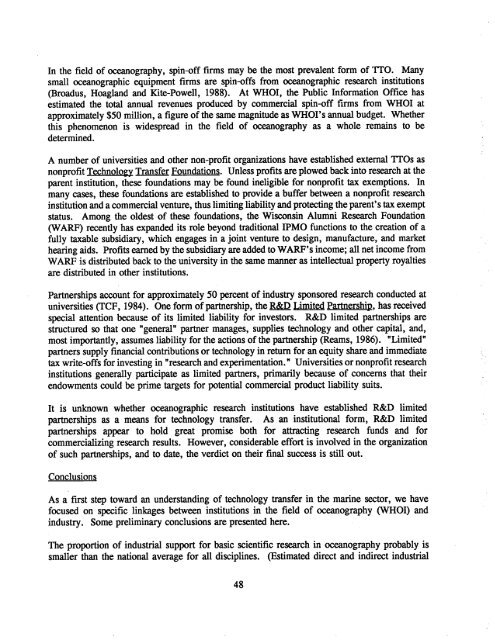WHOI-90-52
WHOI-90-52
WHOI-90-52
You also want an ePaper? Increase the reach of your titles
YUMPU automatically turns print PDFs into web optimized ePapers that Google loves.
In the field of ocography, spin-off firms may be the most prevalent form of TTO. Many<br />
small oceaographic equipment firms are spin-offs from ocographic resech institutions<br />
(Broadus, Hoagland and Kite-Powell, 1988). At <strong>WHOI</strong>, the Public Information Offce has<br />
estimated the tota annual revenues produce by commercial spin-off firms from <strong>WHOI</strong> at<br />
approximately $50 milion, a figure of the same magnitude as <strong>WHOI</strong>'s annua budget. Whether<br />
this phenomenon is widespread in the field of ocography as a whole remains to be<br />
determined.<br />
A number of universities and other non-profit organizations have established external TTOs as<br />
nonprofit Technology Transfer Foundations. Unless profits are plowed back into resech at the<br />
parent institution, these foundations may be found ineligible for nonprofit ta exemptions. In<br />
many cases, these foundations are established to provide a buffer between a nonprofit resech<br />
institution and a commercial venture, thus limiting liabilty and proteting the parent's ta exempt<br />
status. Among the oldest of these foundations, the Wiscnsin Alumni Resech Foundation<br />
(W ARF) recntly has expanded its role beyond trditional IPMO functions to the creation of a<br />
fully taable subsidiar, which engages in a joint venture to design, manufacture, and market<br />
heang aids. Profits eaed by the subsidiar are added to W ARF's income; all net income from<br />
W ARF is distrbuted back to the university in the same manner as intellectual property royalties<br />
are distrbuted in other institutions.<br />
Parnerships accunt for approximately 50 percent of industr sponsored resech conducted at<br />
universities (TCF, 1984). One form of<br />
parnership, the R&D Limited Parnership, has recived<br />
speial attention becuse of its limite liabilty for investors. R&D limite parerships are<br />
strctured so that one "genera" parer manages, supplies tehnology and other capita, and,<br />
most importtly, assumes liabilty for the actions of<br />
the parership (Reams, 1986). "Limited"<br />
parners supply financial contrbutions or technology in return for an equity share and immediate<br />
ta wnte-offs for investing in "resech and experimentation." Universities or nonprofit reseach<br />
institutions generaly parcipate as limited parers, primary becuse of concerns that their<br />
endowments could be prime tagets for potential commercial product liabilty suits.<br />
It is unknown whether ocographic resech institutions have established R&D limited<br />
parerships as a meas for tehnology trasfer. As an institutional form, R&D limited<br />
parerships appe to hold great promise both for attcting resech funds and for<br />
commercialzing resech results. However, considerable effort is involved in the organization<br />
of such parerships, and to date, the verdict on their final succss is still out.<br />
Conclusions<br />
As a first step toward an understading of technology transfer in the marne setor, we have<br />
focuse on speific linkages between institutions in the field of ocography (WO!) and<br />
industr. Some preliminar conclusions are presente here.<br />
The proporton of industral support for basic scientific resech in ocography probably is<br />
smaller than the national average for all disciplines. (Estimated direct and indirect industral<br />
48
















